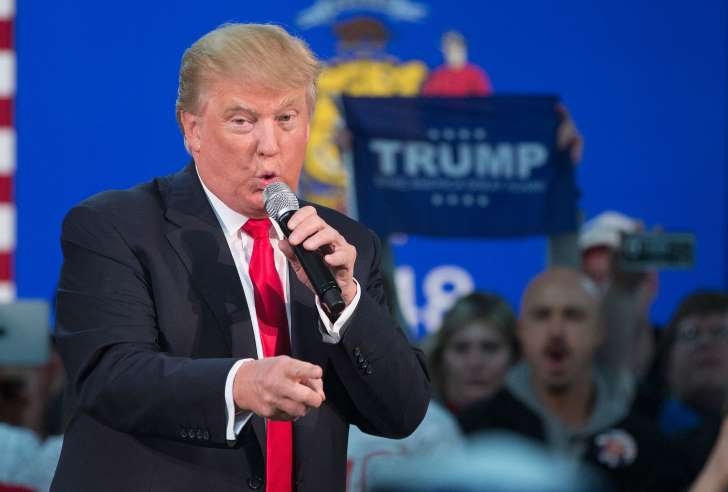January 23, 2017
The TPP is DOA.

From left, White House Chief of Staff Reince Priebus, National Trade Council adviser Peter Navarro, … Image: Trump signs executive orders, Jan. 23, 2017.
January 23, 2017
The TPP is DOA.

From left, White House Chief of Staff Reince Priebus, National Trade Council adviser Peter Navarro, … Image: Trump signs executive orders, Jan. 23, 2017.
President Donald J. Trump signed an executive order Monday announcing the U.S. will withdraw from negotiating the TPP, or Trans-Pacific Partnership deal.
"Great thing for the American worker, what we just did," he told the press corps after signing, as his chief adviser Steve Bannon, former executive editor of the alt-right platform Breitbart.com, looked on with a tight grin.
During a campaign stop in Ohio this summer, Trump said, "The Trans-Pacific Partnership is another disaster done and pushed by special interests who want to rape our country, just a continuing rape of our country."
As divisive as that language sounds, whoever got into the White House was likely to ditch the TPP. Hillary Clinton, adopting a progressive issue from Bernie Sanders, also came out against the deal during her run, saying in August, "I will stop any trade deal that kills jobs or holds down wages, including the Trans-Pacific Partnership. I oppose it now, I'll oppose it after the election and I'll oppose it as president."
So what was the TPP, and why did some people hate it so much — on both the right and the left?
Jobs Created and Destroyed
The Trans-Pacific Partnership, pushed hard by the Obama administration, was essentially an attempt to create a single market for the U.S. and 11 countries that border the Pacific Ocean, including Canada, Mexico, and Chile. The idea was to make goods flow more freely and cheaply between all partners — who together represented one third of global trading.
More particularly, the TPP's largest goal was to maintain U.S. trade dominance in Asia, bringing the various trading partners under America's wing as a way to ward off China's growing economic influence, said MSNBC business correspondent Ali Velshi.
The idea was that if everyone brought down taxes on exported goods, U.S. companies would pay less for imports — while benefiting from cheaper labor overseas.
According to research by the Peterson Institute, the deal would have increased U.S. exports by $123 billion. Using back-of-the-envelope math, Obama's White House had estimated an increase of 650,000 jobs.
Proponents said the net effect of this would lead to overall economic improvement and stimulate the economy and thus jobs and better wages for all, even blue collar workers.
In "The Case for the Trans-Pacific Partnership," Mireya Solís, a foreign policy senior fellow at the left-leaning Brookings Institution, wrote that the deal would "promote jobs in the sectors where we enjoy comparative advantage," would "ensure fair competition," and "put pressure on non-member countries to reform their state capitalism trading practices."
A Trade Deal Without Trade Benefits
But when it comes to deals like these, including NAFTA, another trade deal also on Trump's chopping block, "It just hasn't worked. That's the problem," said Velshi.
The issue is that although the government is helping creating wealth for these companies, there's no mandate that they spend it on hiring or wages.
"Companies love free trade," said Velshi. "Companies get to share profits with shareholders, the government gets the taxes, but workers don't get their fair share."
"This is all diplomacy. There is no benefit," said Derek Scissors, a China specialist at the conservative American Enterprise Institute. "The idea was diplomatic rather than economic."
Moreover, as the deal went along and corporations began influencing it behind the scenes, it became a multinational corporate grab-bag, said Evan Greer, campaign director of Fight for the Future, a non-profit advocacy group that came out strong against the TPP.
"The TPP's 5,000+ pages actually had very little to do with trade. Instead, corporations tried to turn it into a wish list for policies that they knew would never pass through Congress," said Greer.
These included labor rights rules unions said were toothless, rules that could have delayed generics and lead to higher drug prices, and expanded international copyright protection.
"That's what led to such a mass movement against the TPP, and brought together so many different groups to oppose it," she said.
Now that the TPP is effectively dead, Trump's administration will have to make separate trade deals with each country. That can take time. Negotiations for TPP itself began in 2008.
In the meantime, the protectionist measures instead promised by Trump could set off a damaging trade war. And with the U.S. bowed out, it sets the stage for China to make attractive agreements with the Pacific Rim countries to trade with them instead.
That could lead to higher prices for the cheap imports that Americans have become addicted to — so your kid's plastic Paw Patrol toys at Wal-Mart could get a little pricier.
Courtesy: NBC News
















































































































